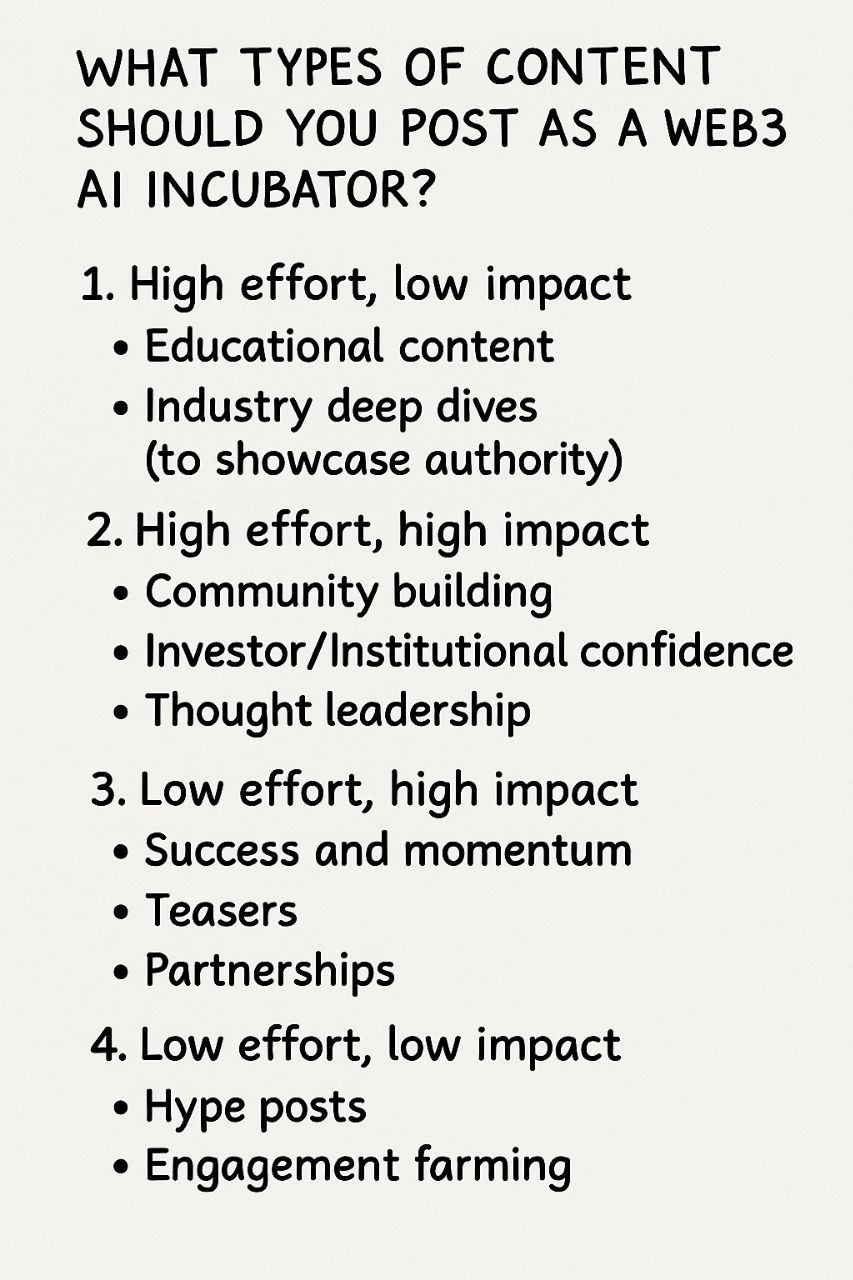So, you want to build a Web3 AI incubator, one that will stand out, but not sure where to start? This template breaks it down into all the bits.
Here’s what this process entails:
- Your incubator’s branding
- GTM template
- Co-marketing strategy
- Types of content you should post
1. Your Branding
-
Create a one-liner tagline – a simple sentence that people can use to easily explain why your incubator should be at the top of their minds.
-
Your incubator’s value proposition – What does your incubator uniquely offer to early-stage Web3 AI projects?
-
Access to infra? Community? GTM help? Narrative strategy? On-chain tools?
-
Target audience – Ideal Projects/Founders. Who should apply? AI infra? LLM tools? Autonomous agents? Builders with strong tech, weak GTM?
-
Ideal customer profile (ICP)
- Founders looking for support
- Users who want to try top-notch AI tools
- Web3 degens curious about AI
- VCs hunting early deal flow
-
Build trust
-
Host spaces regularly
-
Create in-depth market research
2. GTM Template
Your go-to-market template for projects should include:
- Unique value proposition – What is the project offering, and why does it matter?
-
Target audience and personas – Who are they building for?
-
Market positioning – Where do they fit in the market? Is it a new category or a better version of existing products?
-
Is it product, community, founder, or narrative led?
- Narrative– What makes the project stand out in its niche? It should be reflected in all content materials.
- Marketing strategy – What tactics would be used for GTM and retention campaigns, + how would you track performance?
- Distribution strategy – What channels would be used, e.g, social media, billboards, etc.?
-
White paper – Sometimes, Web3 natives lose trust in a project if they can’t find the white paper to understand the project and tokenomics. Ensure this is ready when any project is launched.
==Need an outstanding white paper? Send an email to web3.talez@gmail.com==
- Community: It’s important to build a tribe before launch. These are early adopters or fans.
- Identify the channels for community engagement and also create a roadmap for incentivising them – think long term and not necessarily a one-off to instigate hype and get them disappeared before the product comes to life.
- Provide value through AMAs, exclusive access.
-
Budget – What is the duration of the campaign, and how much will be spent?
-
Growth framework – How do you want the project to grow from 0-100 within a specific timeframe? At this point, you’re not focused on only the GTM but also retention and growth strategies.
-
Think: referrals, user-generated content and features (depending on the product), leaderboards, staking, NFT gating, etc.
-
Track analytics, experiment, and continuously adjust.
- Pitch deck – Each project must have a comprehensive document answering the project’s important questions like:
- Name of project and tagline
- Info on founders, especially career experience
- Clear pain point + why it’s better than competitors + why now
- Demo on how the product works
- Size of the market, amount raised, valuation, and how funds will be used
- Business model – how revenue will be made + token utility and tokenomics
- GTM + retention strategy
- Roadmap
- Contact details and call to action
- PR – Build relationships with Web3 media firms and influencers to collaborate easily on press releases and campaigns.
- VC – As an incubator, it is expected that you have some level of VC relationship to help projects raise funds even when starting out.
- To earn greater VC trust, ensure projects have outstanding pitch decks, a genuinely active community, and a proven track record of performance with strong future potential. This will be appealing to VCs.
3. Co-marketing
In Web3, lazy marketers often reduce co-marketing to a simple partnership announcement. But it’s much more than that. All parties involved should actively brainstorm campaigns that benefit both their brands and their communities. These collaborations are also top-of-funnel activities that can bring new people into your ecosystem. Here’s how you could plan your co-marketing, especially when making announcements on collaboration:
- Use the Chainlink strategy—every collaboration should be an opportunity for you to be discovered (this is the top of the funnel). n
- Every time a project joins, both parties should:
- Write a blog post
- Share posts on X
- Cross-amplify the news through retweets and replies
- Create a marketing campaign
- Host an X space
4. What Types of Content Should You Post?

- High effort, low impact
- Educational content
- Industry deep dives (to showcase authority)
- High effort, high impact
- Community building
- AMAs
- Memes
- User generated content
- Content contests
- Investor/Institutional confidence
- Roadmap breakdown
- Investment reports
- Thought leadership
- Hot takes
- Trend-based threads
- Spaces discussions
- Explainer videos
- Low effort, high impact
- Success and momentum
- Investment news
- Contests, airdrops, or giveaway announcements
- Teasers
- Partnerships
- Accelerator results /project’s performance
- Low effort, low impact
-
Hype posts
-
Engagement farming
==Getting all of this right can be exhausting. Reach out to web3.talez@gmail.com for help==